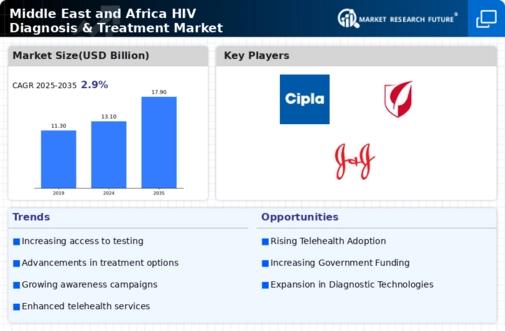Hiv Diagnosis Treatment Size
HIV Diagnosis Treatment Market Growth Projections and Opportunities
HIV diagnosis and treatment market is affected by a host of factors that collectively determine its dynamics and growth. One key factor is the rising prevalence of HIV/AIDS worldwide. The ongoing virus transmission makes it necessary to introduce new diagnostic techniques and methods of treatment. Besides, the market is highly influenced by government initiatives and healthcare policies which greatly affect the accessibility and affordability of HIV testing as well as therapy. For instance, governments start up subsidies, funding, and awareness campaigns thus helping to expand the market in developing regions where HIV burden is usually higher.
Besides, technological advances are important drivers for this market’s growth. In fact, with improved methods for diagnosing HIV infections available today patients can be given more effective antiretroviral therapies. This includes rapid diagnostic tests, point-of-care devices, nucleic acid testing whose development has altered this industry landscape allowing faster detection of viruses with greater efficiency. Additionally, the introduction into the market of newer antiretroviral drugs having better safety profiles but fewer side effects adds to its expansion through offering more potent tolerable treatments for patients.
Global partnerships between pharmaceutical companies, research institutions and NGOs also contribute largely to the overall shape of the market for HIV diagnosis and treatment (Barton-Grimley 79). These collaborations help in fueling research processes; exchange knowledge as well as sharing resources (Lemoine et al., 2019). Stakeholders in this sector can leverage their expertise and resources to speed up innovation processes leading to introduction of new diagnostic methods or even better remedies when they join forces.
The socio-economic factors affecting this market cannot be overemphasized (Raghunath et al., 2020). Economic conditions within a certain region together with healthcare infrastructure including educational levels all play big roles in determining how widespread HIV becomes within a given population or how people are able to access medical services (Ragnauth et al., 2020). On low income countries, HIV-related services’ cost and availability become the key market factors that impact on use of diagnostic technologies and ARVs.
Thus, public awareness and stigma about HIV/AIDS are also important drivers for the development of this market. Consequently, increasing awareness campaigns and educational programmes can result in higher testing rates, early diagnosis as well as timely treatment initiation (Gottschalk et al., 2020). Conversely, persistent stigmas or myths may stop people from accessing HIV care thereby hindering market growth. Thus, community involvement along with education to decrease stigma is vital for ensuring comprehensive HIV care.
Moreover, the regulatory environment significantly impacts on the market for HIV diagnosis and treatment (Kassaye et al., 2019). There are strict regulatory requirements that need to be followed when it comes to approval of diagnostic tests as well as drugs used in treating this disease thus guaranteeing their safety yet at times slowing down innovations entering into the market. Regulatory frameworks differ globally making careful consideration of such diverse needs a key issue that should be taken note by companies operating within the HIV healthcare sector.”







Leave a Comment